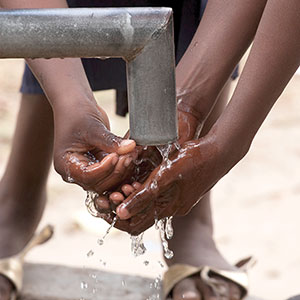
|
| Columnist Porky Cutter’s son, “Piglet,” will leave people he’s teaching in Tanzania with a valuable skill — how to use a rig to drill for water — when he finally returns to the States. Source: iStock |
Once he arrived, he removed the box covering the drill and mounted it on a truck. Because he didn’t know where to get things and he had to locate the students to assist and teach, it took a month to get the rig mounted. Then he had to locate other needed supplies. This required traveling to, and staying overnight in, another city some distance away.
(Piglet sent me an email on June 13, his birthday, saying that he just had an opportunity of a lifetime, celebrating his 50th birthday in Tanzania.)
Since well casing wasn’t available locally, he had to travel by boat — staying overnight in a cabin on the boat — to another city on Lake Victoria. Once he arrived, I understand that he had to rent a vehicle to locate casing.
Piglet also needed wood sills and wood blocks to support the drill, and was having a problem locating them. In an email, I suggested that the railroad would probably give him a few railroad ties. There are railroads in Tanzania. I don’t know how that worked out.
While he was waiting on supplies to arrive, he met some people that owned a local hotel in the city and had a fishing boat on a trailer, but didn’t know how to get it to and into Lake Victoria. So, Piglet made them a makeshift hitch on their pickup, towed the trailer to the lake, backed the trailer into the water and launched the boat. After a few problems with the boat motor, they were able to go boating. These kind of diversions can help drillers stay busy as they wait.
They were finally able to get the rig and equipment to a church-based children’s school about an hour from the main church compound. Piglet and the drill students were provided with basic housing and cooking facilities. Piglet then returned to the base city to obtain groceries.
After starting the hole, then losing the drill tools in the hole and fishing them out, they were able to drill a well some 128-plus feet deep at a church-sponsored school about an hour from his base camp at the main church compound.
I was able to communicate with Piglet about once a week by email and cellular phone until he lost his cellular phone.
We hadn’t heard from him in two weeks, so I called the church contact in the United States. He advised me that an associate that was working with Piglet in Tanzania had just returned to the U.S. and advised that the well was in, the casing installed and a well pad had been poured.
Three months later, Piglet is locating and purchasing a submersible pump and related supplies.
The United States contact advised me recently that Piglet is planning to return to home base in Virginia around Oct. 31. That’s 148 days to drill one well and install a pump. However, he’s teaching people a trade that will make them valuable people in their area (water well drillers) and stay with them for the rest of their lives.
Nothing happens fast in Tanzania.
I think Piglet has found his forte, as he loves teaching water well drilling. Most drillers don’t make good teachers because it takes patience and persistence, which many don’t have.
Keep watching for Piglet’s several part article about his experience in Tanzania. I believe you’ll enjoy it.
For more Porky columns, visit www.thedriller.com/porky.



Report Abusive Comment